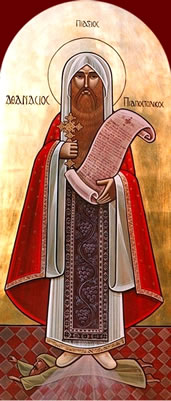Four Ecclesiastical Centers and Four Imperial Players
By the beginning of the fifth century there were four major centers of administration and influence within the Christian church under Roman rule – Rome, Constantinople, Alexandria, and Antioch. While Milan and Carthage were still important voices in the western Latin half of the empire, Rome had become the unquestioned voice there. In the Greek east, however, the three cities with their regional leaders or patriarchs all had both credits and debits in their histories.
Antioch could claim to be the oldest, and associated itself with the apostles including Paul. Its influence had been severely weakened by the long-standing internal contentions between multiple rival groups and bishops that had begun about 360 and was not definitively ended until 415.
Alexandria, the next oldest center, claimed St. Mark the Evangelist as its putative founder, and could boast of such champions of orthodoxy as Athanasius. It, however, also had been the home of Origen, whose orthodoxy had been increasingly questioned, and, under Bishop Theophilus (385-412) Christian groups were involved in the civic unrest that resulted in pogroms against Jews, Christian sects, and pagan cults and philosophers.
Constantinople, founded by Constantine in 325, coopted the bishops of the previous city (Byzantium) into its ecclesial family tree. But its claim to influence was as the capital city of the eastern empire. At the Second Ecumenical Council, which it hosted in 381, it was declared to be second in rank/honor to Rome alone. This created tensions not only with Antioch and Alexandria, but also came at the expense of the other nearby ancient see of Ephesus. In addition, it experienced major disruptions when its patriarch John Chrysostom was deposed by a council in 403, restored briefly, then permanently exiled.
Outwardly, by 418 all of the four major sees were enjoying fairly harmonious relations with each other; underneath, there were still major political and historical tensions. There were theological tensions as well. The ones most commonly discussed are the Antiochene tendency towards a more literal interpretation of Scripture and a focus on the total manhood of Christ, as opposed to the Alexandrine penchant for a more spiritual (sometimes referred to as allegorical) approach to interpretation, and a stronger concern to emphasize the total deity of Christ. Rome, on the other hand, was more concerned about eliminating the influence of Pelagianism, and less with the interpretational and Christological discussions of the eastern church. All of this would play into controversies of the first-half of the fifth century.
When the eastern emperor Arcadius died in 408 (his wife Aelia Eudoxia had died in 404), he left behind four surviving children. Although 10-year old Pulcheria (b. 398/399) was the eldest, her 7-year old brother Theodosius II (born in 402) was technically declared emperor (Augustus), with two aristocrats serving as regents. In 414, however, the 15-year old Pulcheria had the regents dismissed and she was given the title Augusta and in essence she ruled for her brother. At the same time, she also took a vow of virginity and continued to live a quite ascetic life inside the palace in Constantinople. Even after Theodosius was declared Augustus (416), Pulcheria remained a powerful force in the imperial household.
When Theodosius married Eudocia in 421, the latter became a palace rival to Pulcheria. The ascetic Pulcheria, devoted to the virgin and supported by the local monastic communities, eventually became an opponent of Nestorius although this might not have been until after the council of 431. Eudocia, allied with the eunuch Chrysaphius, seems to have been more supportive of the new patriarch Nestorius. Theodosius attempted to remain objective towards the issues, but may have been pressured by both women.1
Theodosius had no male heirs at the time of his death in a riding accident in 450. A month after his death, the military leader Marcian became the new Augustus after marrying into the royal line by wedding the aging Pulcheria. It has been suggested that the negotiations included Pulcheria’s demand that the new Augustus convoke a church council to deal with the lingering Christological problems. This Platonic marriage allowed her to both continue her political influence and her virginal lifestyle until her death three years later (453). Marican died four years after that in 457.
Thus Pulcheria and Eudocia were major players in the controversy, perhaps almost as much as Theodosius and Marcian.
Back to Documents and Events Leading up to the Council of Ephesus (431)
Next: The Development of the ‘Nestorian Controversy’ (through A.D. 429)
Last updated 9/17/24 by JSW
- In his introduction to the translation of the Council of Ephesus documents (p. 24-25), Graumann urges caution about seeing the two augustae/empresses as having hardened positions on Nestorius before the council.
No Responses yet
